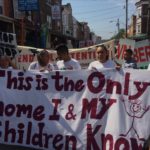From the outside, Acorn Tree Group Family Child Care* in the University Heights neighborhood of the Bronx seems warm and inviting. A green awning with the daycare’s name and logo stretches from the white, red-trimmed home. A ramp eases the way for strollers. Go through the front door and you’ll smell curry cooking. A creaky staircase leads upstairs, where the family who owns the daycare lives. To the right is the daycare itself, shrouded from view by gauzy gold-striped curtains and a glass door with a pink sticker letting it be known that breastfeeding is welcome here.
This article, the fourth in a series, was written by Kendra Hurley as part of the new report, Bringing it All Home: Problem’s and Possibilities facing NYC’s Family Child Care.
But enter the daycare, comprising two large rooms, empty except for a few bins of toys, some play yards and an elaborately patterned carpet, and nothing feels quite right. The rooms are dim and musty. Though it is warm outside, the windows are closed tight and the air feels stale, lifeless. Of three overhead light bulbs, only one works. But mostly, it is preternaturally quiet. “Too quiet,” Marivel Colon, a family child care educational aid from the social service organization Women’s Housing and Economic Development Corporation (WHEDco), will later tell her colleagues. Mostly, you would never guess there are children here.
Colon, a former teacher and principal with a no-nonsense sensibility, turns to Raya Uddin, the daycare owner. She peers at Uddin over black-rimmed glasses. Uddin is girlish—when she laughs, she covers her face with a hand—but she has a son old enough to be in college. Her husband is forever a few steps behind or to the side of her. Both are dressed in the traditional clothes of Bangladesh, their homeland, she with a bright orange and gold scarf draped about her head, he in all black. “Where are the children?” Colon asks.
Wordlessly, Uddin leads Colon and her colleague, Charmaine Swearing, through the rooms. Her husband trails behind. Uddin swings open a door to the kitchen. There, two stunned-looking African-American toddlers sit at a tiny table. A third child, also African-American, is strapped to a booster chair near a cabinet a few feet away. The children blink at the visitors, expressionless. It is a stark contrast from another group family child care program that Colon and Swearing have just come from. There, when they entered, the children flocked about them, eager, full of life, joyful and curious to know who these visitors were.
At the stove, Uddin’s assistant stirs macaroni and cheese in a tiny aluminium pot. She plunks a small bowl in front of a little girl.
“Oh, they’re eating lunch,” says Colon. Throughout much of this site visit, Colon, bilingual in English and Spanish, will provide many of the words spoken. This is partly of necessity: Neither Uddin, her husband nor her assistant speaks much English and no Spanish. The children, who most likely hear English at home, are still learning to speak.
“No vegetables?” Colon asks the assistant. Suddenly, the girl begins to gag on the macaroni and cheese. She silently struggles, mouth open. It lasts only a few seconds, but feels like much longer. She spits up her food. No one moves to help or comfort her, and she doesn’t seem to expect it.
Uddin says she thinks the girl is getting sick. Colon tells the assistant to please clean up and the assistant wipes the spat-up food from the table. Then Colon tells her to wipe the girl’s face, which is still covered with food. The assistant returns to do that too. She does so efficiently and silently.
Later, sharing Twizzlers in a car headed back to WHEDco’s office, Colon and Swearing will put words to what is wrong. These small children are supposed to be learning language, but in this home, they are rarely spoken to. Whether for lack of a common language, lack of an understanding on Uddin’s part on how to help them or lack of interest, it seems that at Acorn Daycare children are being warehoused more than nurtured.
Acorn Family Daycare is just one of over 13,000 of the city’s subsidized child care programs that are run out of a private family home where the vast majority of New York City babies and toddlers receiving subsidized child care spend their time. These home-based arrangements span everything from informal agreements with grandparents to signed contracts with small child care center–like programs.
The problems that often plague families living in poverty can also trouble these home programs. Home providers are often isolated and, like the families they serve, living in or on the brink of poverty.
One large study of nonfamilial family caregivers found that over 9 percent reported clinical depression. For those working in family child care settings, depression was more closely linked with negative behaviors such as being more withdrawn and showing less sensitivity toward children. Other studies have found that, on the whole, family child care providers have lower education levels than center-based caregivers. The quality of the care they provide can vary greatly from home to home, but has been found, on average, to be of lower quality than that at child care centers. “The training and capabilities of the caregiver are lower in family settings,” says Steven Barnett, director of the National Institute for Early Education Research at Rutgers University. “If you’re just sitting in front of a TV, it doesn’t matter how small the [child-to-provider] ratio is, that’s not good.”
Children from low income families rarely wind up in the family-run programs that would give them the best start in life
Children from low income families—the ones research shows have the most to gain from rich learning environments and the most to lose from poor ones—rarely wind up in the family-run programs that would give them the best start in life. In one study published by the National Center for Education Statistics, 90 percent of home-based daycare arrangements rated as “poor” or mediocre. For children living in poverty, only 4 percent of home-based daycare arrangements rated as “high-quality.” Many programs provide care of a quality so low it could harm children’s development, says Barnett. One research paper referred to this as a “crisis in the quality of child care” in low-income communities.
Despite EarlyLearn’s Reforms Raising the Quality of Care Remains A Challenge
NYC’s broad childcare reforms, known as EarlyLearn have attempted to raise the bar for its family child care programs. To that end, it now asks its home-based providers to meet many of the same requirements for teachers in the more formal child care centers. But when the Center for New York City Affairs (CNYCA) at the New School surveyed the social service network organizations charged with monitoring and supporting the subsidized home programs, the staff repeatedly said that it is the requisite home visits—unique to family child care—that hold the most potential for improving quality in these programs. On these visits, network staff go to a program to observe and work one-on-one with the provider.
Staff repeatedly said that it is the home visits—unique to family child care—that hold the most potential for improving quality in these programs
They say these home visits allow them to observe the children in a program while also delivering individualized attention and instruction to a diverse workforce. They can also bring much-needed support and camaraderie to a group of providers who are infamously isolated and overextended, sometimes working alone or with one other assistant for minimal pay.
Emerging research echoes this, with some studies suggesting that home visits where a home provider works collaboratively with a professional support staff can be key to improving quality.
Read: NYC Underestimates Value of Family Child Care For Immigrant Communities.
So far, the EarlyLearn reform provides very little direction on any of these issues, and network organizations set their own protocol for everything from who does the home visits, to how many cases they carry, to when they should remove EarlyLearn children from a program and call in the Department of Health, which has the authority to revoke a program’s license.
As a result, the types and quality of supports that the home programs receive can vary widely from network to network and even staff member to staff member. So does the pay and experience of home visitors.
Addressing safety issues is usually more clear cut, and Swearing and Colon say they have learned to be mindful that no matter how good a program appears, things can change. A provider’s priorities can shift; she might have new pressures placed upon her; and you can never know quite what to expect when you knock on a door.
Each EarlyLearn network determines when and how to sever a provider’s contract. At WHEDco, if safety is not an issue and a provider is willing to work toward improvement, they will generally err on the side of helping the provider. WHEDco has removed EarlyLearn children from six of the 50 home-based programs they started out with. Most contracts they terminated because the providers were unwilling to do the work needed to improve.
Raya Uddin at Acorn Day Care has always appeared, if anything, eager to please and eager to improve. “She yeses you to death and smiles,” says Swearing.
And yet, rarely does she do what is asked of her. Swearing and Colon find it difficult to gauge how much of this is because Uddin does not understand, due to language barriers, or simply does not want to make the changes they ask of her. So they give her the benefit of the doubt, clinging to any of signs of progress.
A year ago, for instance, when Colon started at WHEDco and first visited the program, she watched with horror as Uddin’s assistant wiped each child’s runny nose with the same tissue. Now the assistant uses individual baby wipes. An improvement, says Colon, and for the most part she’s no longer worried about the children’s health. “But educationally I’m very worried,” she says.
It can be challenging for any provider to engage kids of a wide age range, so Colon and Swearing have learned upon entering a home, to quickly gauge whether the needs of not only the oldest but also the youngest child are being met. But here, at Acorn Tree, it’s not clear that anyone’s developmental needs are getting addressed. The children aren’t getting the back and forth with caretakers they need for mastering language, says Colon. They aren’t getting that stimulation crucial to their development.
The EarlyLearn reform was, in theory, designed to help with this. Several months ago, Uddin acquired the Creative Curriculum. (She purchased it for $100, as WHEDco requires.) But at this site visit, when asked where it is, she smiles and says she can’t remember. Colon suspects it is still pristine in its cellophane wrapper. And though Uddin claims to have especially enjoyed a recent WHEDco training on healthy eating, the lessons taught there seem lost on today’s lunch menu of macaroni and cheese only.
It doesn’t help that Uddin’s motivation for starting up a daycare is uninspired. “I wanted to work but my husband wouldn’t let me work outside the home,” she explains, her husband nodding agreement.
Recently, Colon gave Uddin an ultimatum: WHEDco will not send more children to this home until they see marked improvement.
But the EarlyLearn tools they are using for improvement seem insufficient for addressing the program’s gaping needs. Today, Colon asks Uddin to set up “learning areas” as prescribed by the Creative Curriculum, and to create a dedicated space for a baby to roll around. As they’ve come to expect, Uddin smiles and nods. But Colon and Swearing know this agreement can mean anything.
In the room adjacent to where Colon talks to Uddin and her husband, it is naptime. The children lie on cots, blinking at the ceiling. The assistant sits on the floor beside them. A paper poster with the ABCs on it loosens from a wall and flutters to the floor. In the still quietness, the girl who earlier gagged on lunch begins softly singing. She sings “not to someone or with someone,” Colon will later point out in the car. “She was singing to herself.”
Indeed, it is a lonely sounding song, like she believes no one here can hear her.
Before leaving, Colon asks Uddin if she has any questions. Uddin, who has struggled for words throughout much of this visit, now has a forceful answer. “Yes,” she says. “Will you send me more children?”
This article is part of a report, Bringing it All Home: Problem’s and Possibilities facing NYC’s Family Child Care, from the Center for New York City Affairs at The New School. The report focuses on home-based centers in the city’s EarlyLearn program.
Fi2W is supported by the David and Katherine Moore Family Foundation, the Ralph E. Odgen Foundation, an anonymous donor and readers like you.




